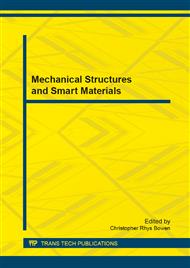[1]
O. Babic, D. Teodorovic, V. Tosic. Aircraft Stand Assignment to Minimize Walking[J]. Journal of Transportation Engineering [J], 1984, 110(3): 55-56.
Google Scholar
[2]
Mangoubi R S, Mathaisel D F X. Optimizing gate assignment at airport terminals[J]. Transportation Science, 1985, 19(2): 173-188.
DOI: 10.1287/trsc.19.2.173
Google Scholar
[3]
Bihr R A. A conceptual solution to the aircraft gate assignment problem using 0-1 linear programming[J]. Computers and Industrial Engineering, 1990, 19(4): 280-284.
DOI: 10.1016/0360-8352(90)90122-3
Google Scholar
[4]
Bandara , Wirasinghe. Walking distance minimization for airport terminal configurations[J]. Transportation Research Part A, 1992, 26(1): 59-74.
DOI: 10.1016/0965-8564(92)90045-9
Google Scholar
[5]
Jiefeng Xu , Glenn Bailey. The airport gate assignment problem: mathematical model and a tabu search algorithm[C]. Proceedings of the 34th Hawaii International Conference on System Sciences, 2001: 1-10.
DOI: 10.1109/hicss.2001.926327
Google Scholar
[6]
S. Yan, Chi-Yuan Shieh, Miawjane Chen. A simulation framework for evaluating airport gate assignments[J]. Transportation Research Part A, 2002, 36(10): 885-898.
DOI: 10.1016/s0965-8564(01)00045-3
Google Scholar
[7]
A Lim, B Rodrigues, Y Zhu. Airport gate scheduling with time windows[J]. Artificial Intelligence Review, 2005, 24(1): 5-31.
DOI: 10.1007/s10462-004-7190-4
Google Scholar
[8]
Shangyao Yan, Ching-Hui Tang. A heuristic approach for airport gate assignments for stochastic flight delays[J]. European Journal of Operational Research, 2007, 180(2): 547–567.
DOI: 10.1016/j.ejor.2006.05.002
Google Scholar
[9]
Wei Dongxuan, Liu Changyou. Study on Airport Gate Assignment Problem[J]. Journal of Transportation Engineering and Information, 2009, 7(1): 57-69.
Google Scholar
[10]
Wei Dongxuan, Liu Changyou. Study on Airport Gate Reassignment Problem[J]. Journal of Nanjing University of Aeronautics & Astronautic, 2009, 41(2): 257-261.
Google Scholar
[11]
Yang Wendong,Zhu Jinfu, Xu Li. Research on the gate assignment problem base on the flight connecting tree[J]. Journal of Shandong University (Engineering Science), 2010, 40(2): 154-158.
Google Scholar
[12]
Zhao Weili. Network Flow Model and Algorithm of Gate Assignment[J]. Journal of Shenyang Ligong University, 2012, 31(4): 48-53.
Google Scholar
[13]
Yin Jianan, Hu Minghua, Zhao Zheng. Simulation model and algorithm of multi-track airport assignment[J]. Journal of Traffic and Transportation Engineering, 2010, 10(5): 71-76.
Google Scholar
[14]
Ching-Hui Tang, Wei-Chung Wang. Airport gate assignments for airline-specific gates[J]. Journal of Air Transport Management, 2013, 30: 10-16.
DOI: 10.1016/j.jairtraman.2013.02.003
Google Scholar


